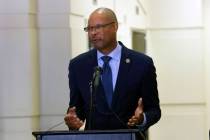Nevada is a welfare case
In December 1935, the Colorado River Commission reported to Nevada Gov. Richard Kirman that if the state built transmission lines to supply power to western and northern Nevada, the cost of electricity to consumers would be reduced.
A year later, no lines had been built, though such a project would have created jobs in Depression-era Nevada. Ten years later, no lines had been built. Half a century later, no lines had been built.
Last month a 231-mile transmission line connecting northern and southern Nevada was dedicated in Moapa. I don’t know if Nevada’s state government had any officials present for the ceremony, but if so, they were there as spectators. The federal government finally got the job done. It’s always easy to take shots at federal spending and the federal government, but Nevada in particular always has its hand out to the feds.
On Feb. 7, Nevada’s Sen. Dean Heller praised approval by the Senate Environment and Public Works Committee of a $415 million measure that Heller co-sponsored to protect Lake Tahoe water quality, deal with invasive species in the Tahoe Basin, lessen wildfire dangers at Tahoe, and fund other environmental needs there.
Yet three days earlier, Heller had denounced the Farm Bill because it fuels “runaway spending that is simply not sustainable.” It’s hard to fault Heller’s statement of praise for federal spending, but it would go down a lot easier if not accompanied by the aftertaste of demagoguery and hypocrisy.
Imagine if the transmission line had been built sooner. How much money would Nevadans have saved in lower electricity rates over EIGHT DECADES?
The fact is that Nevada would barely exist as a civilized place if it weren’t for federal spending. The state has always been a federal welfare recipient. It’s difficult, for instance, to imagine what Nevada would be like if it were not for the New Deal. Nevada was akin to an underdeveloped nation when Franklin Roosevelt took office, a society where everything from highways to hygiene were inadequate. Then the New Deal built the state.
“Per capita expenditures of selected New Deal agencies from 1933 to 1939 were greater for Nevada than for any other state,” historian Russell Elliott wrote in 1973. “Not only was Nevada first in total per capita expenditures, but first, also, per capita in loans, Civil Works Administration (CWA) and Civilian Conservation Corps (CCC) funds, and funds for public roads.”
Reforestation and drought projects came to the state. Schools, bridges, dams, roads went in. To this day, much of the state’s infrastructure dates back to FDR, such as Virginia Lake in Reno, a Las Vegas-Pahrump-Death Valley highway, a water system in North Las Vegas. How many Nevadans would have died without the hygiene projects and clean water the New Deal brought? After the New Deal was gone, Nevada politicians went back to keeping taxes low and counting on the feds to bail them out.
Even under right-wing presidents like Harding, Coolidge and Hoover, the federal government did more for the state than the state did for itself. In 1924 Nevada received 200 percent more funding from the federal government than it contributed in taxes. Nevada lived off other people’s money, but because the state didn’t make similar commitments, it wasn’t enough to make Nevada more than a primitive society that the New Deal, when it arrived, raised up.
It’s not as though state leaders would step in if the feds stopped propping Nevada up. There are regular reminders of the way other states do better than Nevada at governing. Just last month I was covering Nevada and California getting ready to cope along the Sierra with what appears to be a serious drought this coming summer. California is monitoring rural areas where groundwater is always under pressure, beefing up water conservation programs, easing water transfers from areas where water is fairly plentiful to areas that are hurting. Nevada is doing none of this. I found a study by the National Drought Mitigation Center that called Nevada’s drought plan “response based” and California’s plan “mitigation based.”
If at any time the federal government granted the wish of numerous Nevada blowhards and saved all the federal spending that came to Nevadans, the Silver State would tarnish very rapidly, because the officials of our toy state government don’t even try to get serious about doing the job of serving the public that they denounce the federal government for doing.
Dennis Myers is an award winning journalist who has reported on Nevada’s capital, government and politics for several decades. He has also served as Nevada’s chief deputy secretary of state.
















